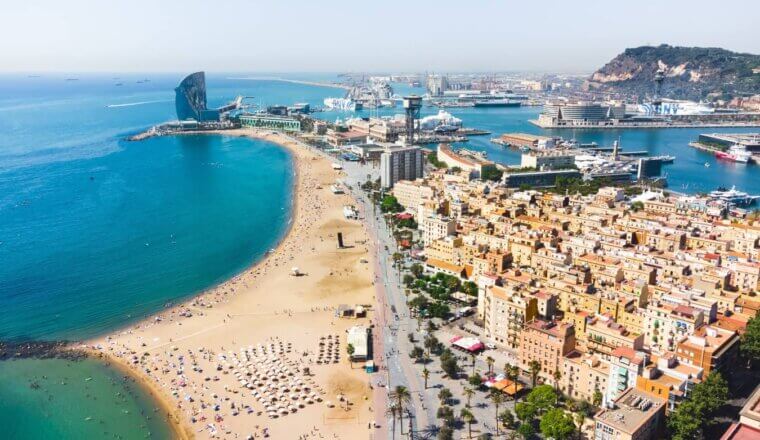
Updated: 6/14/22 | June 14th, 2022
Palau is an island in the South Pacific and is often overlooked in favor of Fiji, Bora Bora, or the Cook Islands. The archipelago is home to over 500 remote tropical islands, making Palau a great destination if you are looking for a nice, beautiful, and quiet escape.
One of the most incredible things about Palau is that it is home to an amazing Jellyfish Lake. Not surprisingly, this is one of Palau’s most famous attractions. Jellyfish Lake is a marine lake located on Eil Malk Island. Every day, millions of golden jellyfish migrate across the lake. While they do this, you can go swimming with them!
Swimming with the jellyfish was actually forbidden in recent years, as the jellyfish population was in decline. However, as of 2019, the jellyfish numbers are on the rise and swimming with them has been reopened.
Jellyfish Lake is around 12,000 years old. It’s a remnant of the last ice age where, during that time, the sea level rose to the point where sea water began to fill the basin. But when the glaciers receded, there was no place for these jellyfish or other fish to go. This isolation allowed the species in the lake to develop on their own and become unique (Darwin would be proud!).
In 2005, there were around 30 million jellyfish in the lake, though that number was in decline for many years. By 2016, there were almost none.
Fortunately, there are now millions of jellyfish in the lake and scientists are optimistic about the numbers continuing to grow.
So, how is it possible to swim with these jellyfish? Will you get stung? Well, this specific species of jellyfish has evolved without their stingers. The jellyfish in the lake live on algae that are attached to them. Twice each day, the jellyfish in the lake swim from one side to the other so the algae they live off of can grow.
Since they live off of algae, they don’t need their stingers to catch prey. That means that you can swim with them and not worry about getting stung.
You’ll be able to swim for hours with these creatures as they migrate from one side of the lake to the other. While Palau might not be one of the biggest destinations in the region, this lake is Palau’s big destination, so don’t expect to be the only one swimming here.
One thing to keep in mind is that scuba diving in the lake is not allowed. This is for two reasons: First, the bubbles from scuba tanks can harm the jellyfish if they collect beneath their bell. Secondly, at about 15 meters below the surface, there are high concentrations of hydrogen sulfide, which can be absorbed through the skin of a diver and cause death.
If you are looking to do something different, try going for a swim with a million jellyfish. Most of the jellyfish in the world sting, and while they are beautiful creatures, you can’t really go swimming with them. Yet here in Palau, nature gives you a chance to get all tangled up without being stung. Don’t miss your chance!
How to Visit the Jellyfish Lake in Palau
Jellyfish Lake (Ongeim’l Tketau) is located on Eil Malk Island in Palau, which is part of the Rock Islands. It’s about 45-minutes from Koror. A 10-day pass for swimming with the jellyfish is $100 USD, though this is not included in the price of most tours.
If you’re looking to book a day tour (which is the easiest way to visit the lake) expect to pay between $100-200 USD (plus the $100 permit). Tours usually include other activities (such as swimming, kayaking, or snorkeling in other locations) in addition to Jellyfish Lake. Viator offers full-day snorkeling trips for $200 USD.
The closest place to depart from is Koror, which is serviced by Roman Tmetuchl International Airport (Palau International Airport).
While tickets used to be quite affordable from nearby destinations, post-COVID they are now extremely pricey (there are fewer connections and fewer direct routes currently). Tickets for the direct 4-hour flight from the Philippines cost around $800 USD round trip while non-stop flights from Guam are just 2 hours but cost around $600 USD round trip.
Wearing certain sunscreens is prohibited during your visit, as the chemicals will harm the ecosystem. If you do bring sunscreen, make sure it is eco-friendly.
F.A.Q About Jellyfish Lake
How long should I plan to visit the lake for?
While you could easily spend a day here (swimming with the jellyfish is not only fun but a once-in-a-lifetime experience, after all!) usually a visit for an hour to two will suffice.
What type of jellyfish are in Jellyfish Lake?
There are two types of jellyfish in Jellyfish Lake, Golden jellyfish and Moon jellyfish — both of which cannot sting you.
Is Jellyfish Lake in Palau open?
As of 2022, Jellyfish Lake in Palau is open to the public.
Is it safe to swim with jellyfish?
It is very safe as the jellyfish don’t actually sting. You just can’t dive deep here (below 15 meters) as there is hydrogen sulfide at the bottom of the lake, which is harmful.
Can you wear sunscreen with the jellyfish?
As long as your sunscreen is eco-friendly, you can. However, harsh sunscreens are prohibited and will be confiscated.
Do I need to book a tour to visit Jellyfish lake?
The easiest way to reach the island is to book a tour with Viator. Tours last a full day and cost around $200 USD per person.
Book Your Trip to Palau: Logistical Tips and Tricks
Book Your Flight
Use Skyscanner to find a cheap flight. They are my favorite search engine because they search websites and airlines around the globe so you always know no stone is left unturned!
Book Your Accommodation
You can book your hostel with Hostelworld as they have the biggest inventory and best deals. If you want to stay somewhere other than a hostel, use Booking.com as they consistently return the cheapest rates for guesthouses and cheap hotels.
Don’t Forget Travel Insurance
Travel insurance will protect you against illness, injury, theft, and cancellations. It’s comprehensive protection in case anything goes wrong. I never go on a trip without it as I’ve had to use it many times in the past. My favorite companies that offer the best service and value are:
- Safety Wing (best for everyone)
- Insure My Trip (for those over 70)
- Medjet (for additional evacuation coverage)
Looking for the Best Companies to Save Money With?
Check out my resource page for the best companies to use when you travel. I list all the ones I use to save money when I’m on the road. They will save you money when you travel too.



